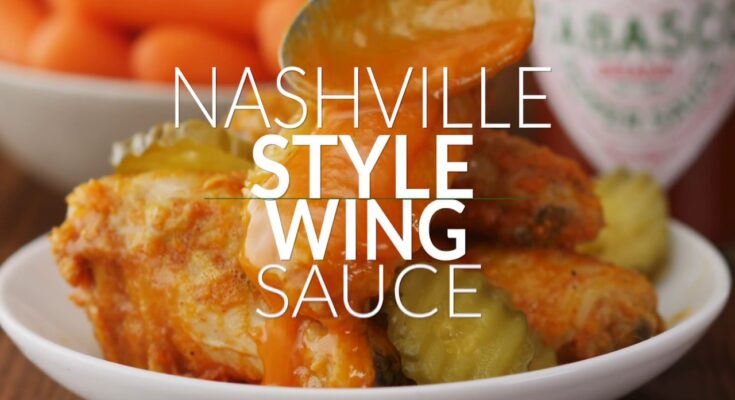Nashville Hot Sauce Recipe: Nashville Hot Sauce is more than just a condiment—it’s a Southern legacy. This fiery, flavorful sauce is a must-have for those who crave a perfect balance of heat, sweetness, and tang. Born in the heart of Nashville, Tennessee, this sauce has become synonymous with “Nashville Hot Chicken,” a dish that has taken the world by storm. Whether you’re a spice enthusiast or just looking to spice up your meals, learning how to make authentic Nashville hot sauce at home is a game-changer.
The History Behind the Fiery Flavor
The origins of Nashville Hot Sauce trace back to the 1930s, with the story of Thornton Prince, who was allegedly served an extra-spicy fried chicken by his girlfriend as a prank. Instead of being upset, Prince loved the heat and opened a restaurant—Prince’s Hot Chicken Shack—introducing the world to this fiery delight. The sauce that coated the chicken was the key—a rich, spicy, oil-based blend that gave Nashville Hot Chicken its unmistakable kick. Over time, the sauce became famous in its own right, now enjoyed not only with fried chicken but also on sandwiches, fries, and even eggs.
What Makes Nashville Hot Sauce Unique?
Unlike traditional hot sauces that are vinegar-based, Nashville Hot Sauce is oil-based, which gives it a smooth, glossy texture and deep, smoky heat. The magic lies in its blend of cayenne pepper, paprika, garlic powder, and brown sugar—creating a bold flavor that’s spicy yet slightly sweet. The oil infuses these spices, delivering a robust and lasting heat that lingers in the best way possible. Plus, its versatility makes it ideal for drizzling, dipping, or marinating.
Ingredients You’ll Need
Let’s talk ingredients! To make Nashville Hot Sauce, you don’t need anything fancy—just a few pantry staples that, when combined, create pure magic.
Core Ingredients for the Base Sauce
Here’s what you’ll need for the authentic version:
| Ingredient | Quantity | Purpose |
|---|---|---|
| Cayenne Pepper | 3 tablespoons | Provides the signature heat |
| Brown Sugar | 2 tablespoons | Balances out the spice with sweetness |
| Paprika (Smoked or Sweet) | 1 tablespoon | Adds color and depth |
| Garlic Powder | 1 teaspoon | Infuses rich, savory notes |
| Salt | 1 teaspoon | Enhances all flavors |
| Black Pepper | ½ teaspoon | Adds mild sharpness |
| Lard or Vegetable Oil | ¾ cup | The carrier for all the spices |
| Hot Sauce (Optional) | 1 tablespoon | Boosts tang and intensity |
These ingredients are the foundation of traditional Nashville hot sauce, offering that fiery, balanced flavor profile everyone craves.
Optional Ingredients for Custom Heat Levels
- Crushed Red Pepper Flakes: For an extra kick.
- Honey: To add a touch of sweetness and a sticky finish.
- Apple Cider Vinegar: For more tang and brightness.
- Chipotle Powder: Adds smokiness and complexity.
- Butter: For a richer, silkier texture.
Want it mild? Reduce cayenne by half. Want it fiery enough to make your eyes water? Add an extra tablespoon of cayenne and a dash of ghost pepper powder.
Ingredient Substitutions for Dietary Preferences
If you’re vegan or avoiding animal fats, swap lard for vegetable oil, avocado oil, or coconut oil. For a lower-sodium version, use sea salt sparingly or opt for salt substitutes. Gluten-free? Don’t worry—this recipe naturally fits that bill since all ingredients are gluten-free by default.
Tools and Equipment Required
Before we jump into the actual cooking, let’s make sure you have the right tools.
Kitchen Essentials for the Perfect Sauce
You’ll need:
- A medium saucepan or skillet (preferably cast iron)
- A heat-resistant spoon or silicone spatula
- A mixing bowl
- A measuring spoon set
- A fine mesh strainer (optional, for smoother sauce)
- A glass jar or bottle with a tight lid for storage
Tips for Safe and Efficient Cooking
Working with hot oil and spices requires caution. Always use medium heat—overheating oil can burn the spices and create a bitter taste. Keep your workspace clear, and avoid adding water to hot oil (it can splatter dangerously). Use a thermometer if possible to ensure your oil stays below 375°F (190°C).
Step-by-Step Guide to Making Nashville Hot Sauce
Now that you’ve gathered your ingredients and tools, it’s time to make some culinary magic. Follow these steps carefully for the perfect balance of heat and flavor.
Step 1 – Prepare the Ingredients
Before turning on the stove, measure out all your ingredients. This preparation—called “mise en place” in the culinary world—ensures everything runs smoothly. Combine all your dry spices (cayenne, paprika, garlic powder, salt, black pepper, and brown sugar) in a small bowl and mix well. This will help the flavors distribute evenly when you add them to the oil later.
Step 2 – Create the Spice Mix
Now it’s time to build that bold, smoky flavor base. In a small bowl, combine all your dry spices: cayenne pepper, paprika, garlic powder, salt, black pepper, and brown sugar. Mix them thoroughly using a fork or small whisk until you have a consistent, fragrant spice blend.
This spice mix is the heart and soul of your Nashville Hot Sauce—it’s where the magic begins. The cayenne brings the fire, while paprika deepens the color and adds a hint of smokiness. Brown sugar balances everything out, giving that perfect sweet-heat profile. If you’re adventurous, you can customize it here: add a pinch of chili powder for an extra punch or a dash of mustard powder for tang.
Once your spice mix is ready, set it aside. You’ll add it to hot oil soon, and trust me—the aroma that fills your kitchen will be absolutely mouthwatering.
Step 3 – Heat the Oil and Infuse Flavors
Pour the oil (or lard) into your skillet and place it over medium heat. Allow it to warm up gently for about 3–5 minutes—you’ll know it’s ready when you can sprinkle in a tiny bit of spice, and it sizzles immediately. Avoid letting the oil smoke; if it does, reduce the heat right away.
Here’s the trick: don’t rush this step. The key to a rich, deep flavor is allowing the oil to heat slowly. When the oil reaches around 350°F (175°C), turn off the heat. Then carefully pour the hot oil into your prepared spice mix (or vice versa if you prefer). The oil will bubble fiercely as it meets the spices—this reaction helps release the full aroma and infuses the oil with vibrant red color.
Stir continuously for 1–2 minutes to ensure all the spices dissolve evenly and nothing clumps together. This step transforms your simple ingredients into that irresistible, fiery base that Nashville Hot Sauce is known for.
Step 4 – Combine and Simmer
Once your spices have infused into the oil, return the skillet to low heat. Let it simmer gently for about 5–7 minutes, stirring occasionally. This simmering process melds all the flavors together and enhances the sauce’s richness.
As it simmers, you’ll notice the sauce becoming thicker and more aromatic—the smoky scent of paprika, the sweetness of brown sugar, and the fiery cayenne blending into one harmonious aroma. Be careful not to overcook or burn the sauce, as this can turn it bitter.
At this point, you can taste and adjust the seasoning. Want more sweetness? Add another teaspoon of brown sugar. Craving more heat? A dash of cayenne or hot sauce will do the trick. Once satisfied, remove the sauce from the heat and let it cool for a few minutes before handling.
Step 5 – Cool, Strain, and Store Properly
Allow your sauce to cool to room temperature before storing. If you prefer a smoother consistency, pour the sauce through a fine mesh strainer to remove excess spice residue. This step gives your sauce a silky texture and a glossy finish—perfect for drizzling over crispy fried chicken.
Transfer the cooled sauce to a sterilized glass jar or bottle with a tight lid. Store it in the refrigerator for up to 3 weeks. If you’ve made a larger batch, consider freezing some portions in small containers. The flavors actually deepen over time, so the sauce might taste even better after a day or two.
Tip: Always shake or stir your sauce before using—it tends to separate slightly due to the oil base.
Tips to Perfect Your Nashville Hot Sauce
Adjusting the Spice Level
Not everyone loves extreme heat, and that’s totally okay! You can tweak the spice level to match your preference.
- For a mild version, reduce the cayenne pepper to 1½ tablespoons and add extra paprika for color without extra heat.
- For medium heat, stick with the original recipe proportions.
- For a spicy kick, increase cayenne by a tablespoon or add a dash of ghost pepper or habanero powder for serious heat lovers.
Remember, heat isn’t just about spice—it’s about balance. A sauce that’s all fire with no flavor won’t satisfy your taste buds. Aim for that harmony of sweet, smoky, and spicy.
Enhancing Flavor with Extra Ingredients
To elevate your sauce even further, try experimenting:
- Add honey or maple syrup for a sticky, caramelized sweetness.
- Splash in some apple cider vinegar to brighten the flavor.
- Incorporate butter for a velvety finish, perfect for dipping wings or brushing over fried chicken.
- Add minced garlic or onion powder for more depth.
Every small tweak can transform your sauce into something uniquely yours. Think of this recipe as your spicy canvas—paint it however you like!
How to Serve Nashville Hot Sauce
Classic Pairings and Dishes
Nashville Hot Sauce is famously known for coating crispy fried chicken, but it doesn’t stop there. Here are some classic serving ideas:
- Nashville Hot Chicken Sandwich: Drizzle the sauce over fried chicken breast, add pickles, and serve on a toasted brioche bun.
- Hot Chicken Wings: Toss freshly fried wings in warm sauce for a finger-licking experience.
- Spicy Fries or Tots: Mix a little sauce with ketchup or mayo for a fiery dip.
- Eggs and Breakfast Dishes: A dash over scrambled eggs or hash browns transforms an ordinary breakfast into something extraordinary.
Creative Uses Beyond Fried Chicken
Don’t limit yourself! Use your homemade Nashville hot sauce as:
- A marinade for grilled meats or vegetables.
- A base for spicy pasta or rice dishes.
- A topping for burgers, tacos, or even pizza.
- A dip when mixed with ranch or sour cream for a creamy-spicy combo.
This sauce is so versatile that once you make it, you’ll find yourself reaching for it at every meal.
Storage and Shelf Life
Refrigeration Tips for Longevity
Proper storage is essential to keeping your Nashville Hot Sauce flavorful and safe to eat. Because it’s oil-based, it doesn’t spoil as quickly as other sauces, but temperature and cleanliness matter. Once your sauce has cooled completely, pour it into a sterilized glass jar or bottle with a tight-fitting lid. Avoid using plastic containers, as they can absorb the strong chili oils and alter the taste over time.
Store your sauce in the refrigerator, ideally in the door or a middle shelf where the temperature stays consistent. It can last up to three weeks when kept chilled. If you made a large batch and want to preserve it for longer, divide it into smaller portions and freeze it in airtight containers or silicone molds. When ready to use, simply thaw it at room temperature or warm it slightly on the stove over low heat.
Always use a clean spoon when scooping sauce from the jar—this prevents bacteria from contaminating the mixture. If your sauce starts to smell sour, changes color, or develops mold, discard it immediately. Freshness and flavor are key to that authentic Nashville experience!
How to Tell if Your Sauce Has Gone Bad
Though oil-based sauces have a longer shelf life, they’re not immune to spoilage. Here are a few signs your sauce might have gone off:
- Unpleasant or sour odor: The oil may have turned rancid.
- Cloudiness or separation: Some natural separation is normal, but milky or opaque layers can indicate spoilage.
- Mold or discoloration: Any visible mold or drastic color change means it’s time to toss it out.
- Off taste: If it tastes bitter or strange, don’t take any chances.
When stored properly, your Nashville Hot Sauce should remain bright red, glossy, and aromatic—just the way it was meant to be.
Health Benefits and Nutritional Value
Key Nutrients Found in Hot Sauce Ingredients
Surprisingly, Nashville Hot Sauce isn’t just about the heat—it also packs a few health benefits! Cayenne pepper, the star of the show, contains capsaicin, a compound known for its metabolism-boosting and anti-inflammatory properties. It can help promote healthy digestion, improve circulation, and even support weight management by increasing calorie burn.
Paprika provides vitamin A and antioxidants, which help protect your cells from oxidative stress. Garlic powder contributes antimicrobial and immune-boosting properties, while the touch of brown sugar provides a small energy lift. Even the oil serves a purpose—it helps your body absorb fat-soluble vitamins like A, D, E, and K.
While the sauce isn’t a “health food,” it’s a flavorful way to add nutrients and excitement to your meals. The key is moderation—just a few drops or spoonfuls can enhance your dish without adding excessive calories.
The Surprising Benefits of Spicy Foods
Beyond flavor, spicy foods have long been celebrated for their health perks. Studies show that consuming spicy ingredients like cayenne and chili peppers may:
- Boost metabolism and promote fat oxidation.
- Support heart health by improving blood circulation.
- Release endorphins, the “feel-good” hormones that can boost your mood.
- Help clear sinuses and relieve nasal congestion.
- Act as a natural preservative due to their antimicrobial properties.
So, next time you drizzle Nashville Hot Sauce on your fried chicken, remember—it’s not just a flavor bomb; it’s also doing your body some good.
Common Mistakes to Avoid
Even the most experienced cooks can make a few missteps when creating Nashville Hot Sauce. Here’s how to steer clear of the most common pitfalls:
Overheating the Oil
One of the biggest mistakes people make is overheating the oil. If the oil smokes or burns, it will ruin your sauce instantly by giving it a harsh, bitter taste. Always heat the oil gently and never let it exceed 375°F (190°C). Remember, you’re infusing spices—not deep-frying them!
If you accidentally overheat the oil, let it cool and start over. It’s worth the extra few minutes to get that deep, rich flavor right.
Using the Wrong Chili Powder Blend
Not all chili powders are created equal. Many store-bought blends contain salt, cumin, or other additives that can alter the taste of your sauce. For authentic Nashville flavor, use pure cayenne pepper powder—nothing else.
Also, avoid substituting chili powder with crushed red pepper flakes as the texture and flavor intensity will differ significantly. If you want extra smokiness, add a pinch of chipotle powder or smoked paprika instead.
A final tip: always taste as you go. Adjusting the seasoning early prevents overpowering heat or unbalanced flavors later on.
Homemade vs. Store-Bought Nashville Hot Sauce
Pros and Cons of Each Option
There’s no denying that store-bought sauces are convenient. You can find bottles labeled “Nashville Hot” in most grocery stores these days. However, while these pre-made versions save time, they often sacrifice freshness and authenticity.
Homemade Nashville Hot Sauce offers unbeatable advantages:
- Freshness: You control the ingredients, ensuring no preservatives or artificial colors.
- Customization: Adjust sweetness, heat, and flavor exactly how you like it.
- Authentic Flavor: The oil-based infusion method at home captures the real Nashville taste.
Store-bought versions, on the other hand, are great for quick use but often lean too heavily on vinegar or stabilizers. They lack that rich, velvety consistency that homemade sauce delivers.
Why Homemade Wins for Authentic Flavor
When you make Nashville Hot Sauce from scratch, you experience the process—watching spices sizzle in hot oil, smelling the smoky aroma, and tasting the perfect balance of heat and sweetness. That’s what makes it truly special.
Homemade sauce also allows you to play with variations. Want a sweet-spicy version? Add honey. Prefer extra smoky? Use smoked paprika or even a dash of liquid smoke. The possibilities are endless—and every batch feels like your personal signature creation.
FAQs about Nashville Hot Sauce Recipe
1. Can I make Nashville Hot Sauce without cayenne pepper?
While cayenne is essential for authentic flavor, you can substitute it with chili powder or crushed red pepper flakes for a milder version. Just note that it won’t have the same classic heat or color.
2. Is Nashville Hot Sauce extremely spicy?
It’s definitely spicy but balanced. You can always adjust the heat level by adding more or less cayenne or mixing in honey for sweetness.
3. How long does homemade Nashville Hot Sauce last?
Stored properly in the refrigerator, it stays fresh for up to 3 weeks. For longer preservation, freeze small portions and thaw as needed.
4. Can I use olive oil instead of vegetable oil or lard?
You can, but olive oil has a distinct flavor that might overpower the sauce. A neutral oil like canola or vegetable oil works best.
5. What foods go best with Nashville Hot Sauce?
It’s traditionally paired with fried chicken, but it’s also fantastic on burgers, fries, tacos, pizza, or even scrambled eggs.
Conclusion
There you have it—a complete, step-by-step guide to making the perfect Nashville Hot Sauce at home. From selecting the right ingredients to infusing the oil and balancing the heat, this recipe captures everything that makes the iconic sauce so irresistible.
Whether you drizzle it over crispy fried chicken, toss it with wings, or mix it into your favorite dips, this fiery blend adds an explosion of flavor that turns any dish into something unforgettable.
Remember, the beauty of Nashville Hot Sauce lies in its simplicity and boldness. A little effort goes a long way in crafting a sauce that’s not just spicy—but memorable. So, roll up your sleeves, grab that cayenne, and bring a little Tennessee heat to your kitchen!



